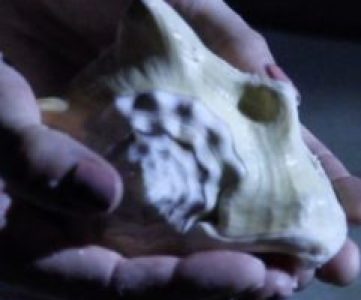Exploratory Workshop PQ 2023: Reflections, Observations, Responses.
TT Journal, ISSUE 6, September 2023
Lucy Algar
Every four years since 1967 the Prague Quadrennial of Performance Design and Space has drawn together theatre makers and performance designers from all over the world. In 2022 I applied to run an exploratory workshop at PQ 2023 entitled Drawing Performance/Performance Drawing. I was thrilled when my proposal was accepted, and preparations could begin. My workshop ran from 13-15.6.23 at DAMU (The Academy of Performing Arts) in Prague and was attended by 20 participants ranging from incredibly experienced designers to students just starting out. My co-leaders were movement artists/choreographers Kirill Burlov and Tina Breiova. We were also joined by two students, Morgan Charlton and George Williams Lane, from the BA Contemporary Theatre Practice course at Wimbledon College of Arts, UAL, where I am Course Leader of the BA Theatre Design course. A post I have held since 2013.
Concept for the workshop: I decided to focus on establishing the connectivity between the act of drawing and the act of performance and observing the interchange that occurs when these two activities share the same space and energy.
It was the following quote, from artist and friend Tania Kovats, that helped form my intentions for the workshop. Tania and I worked together at Wimbledon College of Arts from 2013-2018 when she was Course Leader of the MA Drawing Course. She has published two books on the subject, The Drawing Book: A Survey of Drawing: The Primary Means of Expression and Drawing Water: Drawing as a Mechanism for Exploration.
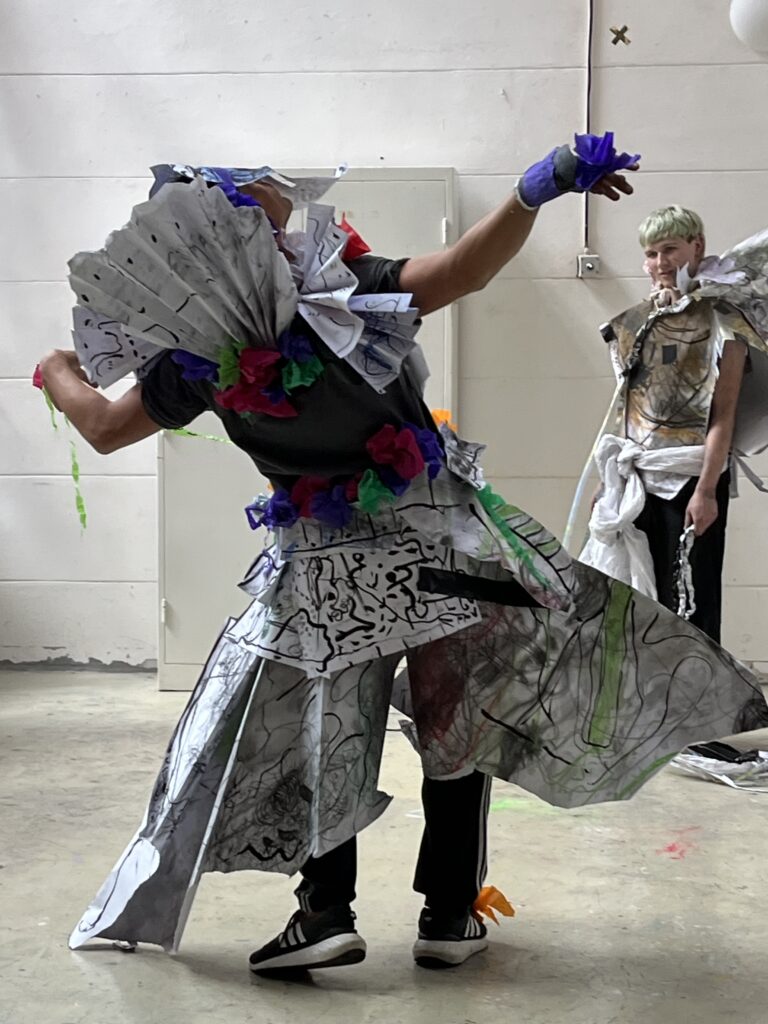
I draw to find my way out. Drawing fills the space when I’m not sure what I am doing. It’s my mechanism for map-making and my search engine, even when I don’t know what I am looking for (Kovats, 2014:11)
My plan was to create a 3-day workshop with the aim of creating a dynamic performative space where the participants, be they performers, performance designers, or educators, could encounter, investigate and participate in each other’s practices. The key process we were going to use to create connections was to be drawing because the brain is forced to engage far more deeply with its subject if it is asked to look and draw in response to what it sees, rather than just observe. Drawing is a vital tool for performance designers, not only to communicate their design ideas but also to provoke and interrogate them when working alone and in collaboration with others. The key aim of this workshop was to give the participants greater confidence in their own range of skills and sensibilities in relation to theatre – making and collaboration. The following quote, from international award-winning theatre designer Alison Chitty, confirms the central role that drawing plays for her when designing sets and costumes.
Designing for the theatre, you must be obsessive, organised, open and free: a balancing act. There are many collaborators and unlimited ingredients, and through drawing I communicate what I am thinking. In a new work we start with nothing, we all need to have solidarity around a black hole and a sense of adventure. Drawing is my way out of the black hole. It is immediate and fast; for me it is the foundation of the design process. (Chitty, 2010)
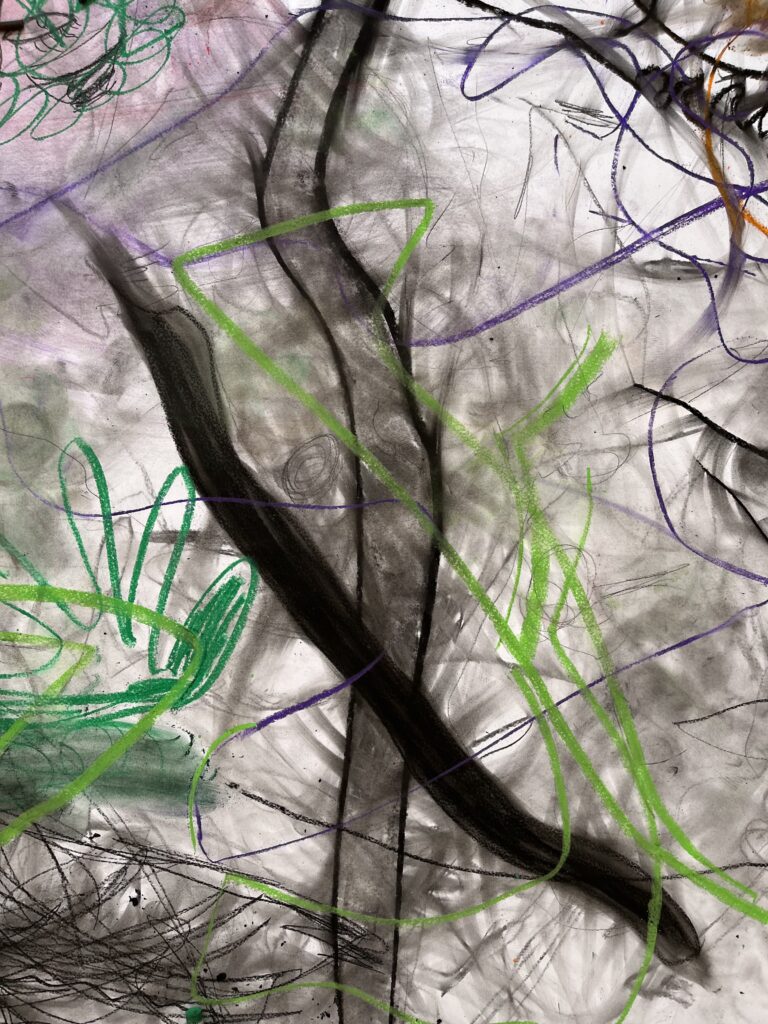
Initial workshop aims and Intentions.
- To bring together performers and designers to encounter the similarities and differences in each other’s practices so that we might build new ways of making performance and develop confidence and resilience in doing so.
- Witness the power of drawing to reveal new possibilities in relation to making and materiality. In particular to encounter new visions of space and set design ideas and understandings about characters and costume design
- Encourage sharing of practices and vulnerabilities in relation to developing performance ideas.
- Let drawing help you to discover, reveal, edit and communicate ideas. Experience the power of drawing to prevent the designer from forcing an idea into shape. Drawing allows, suggests, lets ideas emerge and this workshop will encourage designers to be patient as ideas reveal themselves.
- Let the materials themselves (the floor, costume, paper, charcoal, ink etc) offer understandings, for instance in relation to speed, velocity and gravity…. The participants, whether drawing or performing, should take turns to respond to each other. Time will be given at all stages to stop and acknowledge each participant’s findings.
- Enable participants to feel and gain resilience, in relation to the ebb and flow of a research and development session, in a supported environment. I have discovered that my students gain a huge amount of confidence just through the social interaction that workshops like this allow and encourage. This is in sharp contrast to the comparatively physically inactive processes that designers engage in when model making. The designer can sometimes forget that their own body, not just their mind, can connect them to design solutions. Working alongside performers, as ideas emerge, offers a physically heightened experience.
Our workshop – day by day.
Each day opened with a presentation from me, to contextualise our explorations. I wrote new presentations on day 2 and 3 in response to the previous days’ work. This was followed by a physical warm up for everybody, led on day 1 by Kirill and Tina on day 2. These warm-ups and the movement that grew out of them enabled democratic spaces to open up around physicality, creating unexpected confidences to grow in participants who had hitherto experienced a sense of dislocation from the movement practices of the performers.
We brought a wide range of different papers and drawing tools, such as chalk pastels, ink, charcoal and pencils to the workshop so that multiple playful experiments could be explored. On the first day, we drew on huge rolls of paper which we rolled out through three rooms at DAMU, creating a powerful scenographic intervention. We used the word PHRASE as a lens through which we played with letting go of ideas and seeking new ones. Our scenographic drawing then became the catalyst for further explorations when I asked the participants to form four groups to build costumes, directly on the performers, using tape and all the drawings made earlier in the day. Once costumed we led the performers out into the street and amazed the passing tourists with an exuberant parade. The swift design solutions that the groups encountered through this process brought new and unexpected understandings about the ways in which physical processes and sculpting on the body can bring forth extraordinary ideas efficiently and effectively. They also stated how amazed they were by their ability, as a group, to make decisions swiftly when they trusted the drawings themselves, following the shapes and forms that they suggested, to reveal design ideas and solutions.
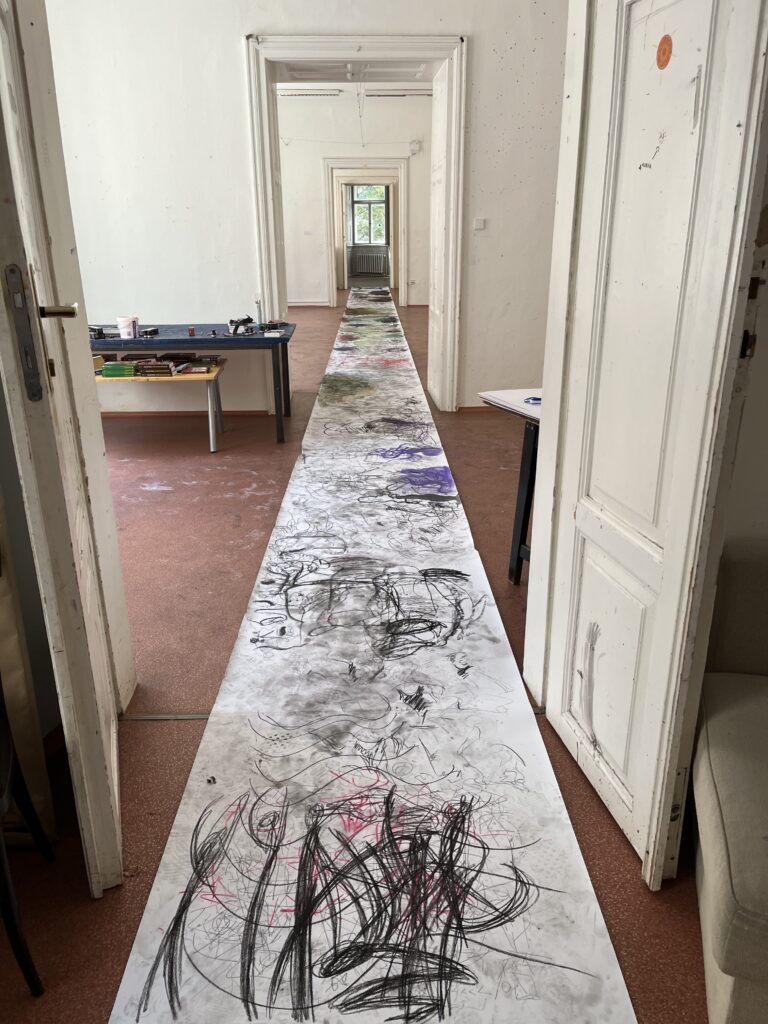
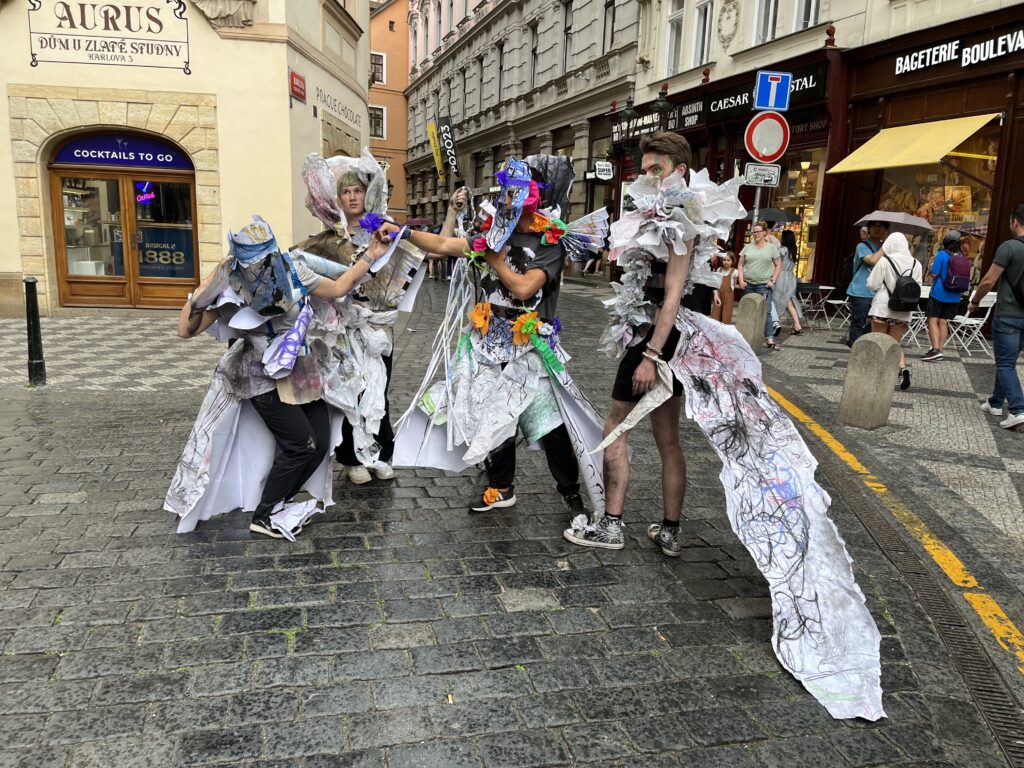
On day two the movement tasks were led Tina Breiova. Once warmed up we drew, danced and began to question spatial awareness and the distances between each other and the audience using the word PROXIMITY as our lens. We also questioned stillness vs movement and body positioning, hierarchies and levels. We drew around the performers as they moved using tape and then used the resulting drawings/ground plans as prompts for discussions about scenographic spacing and placing.
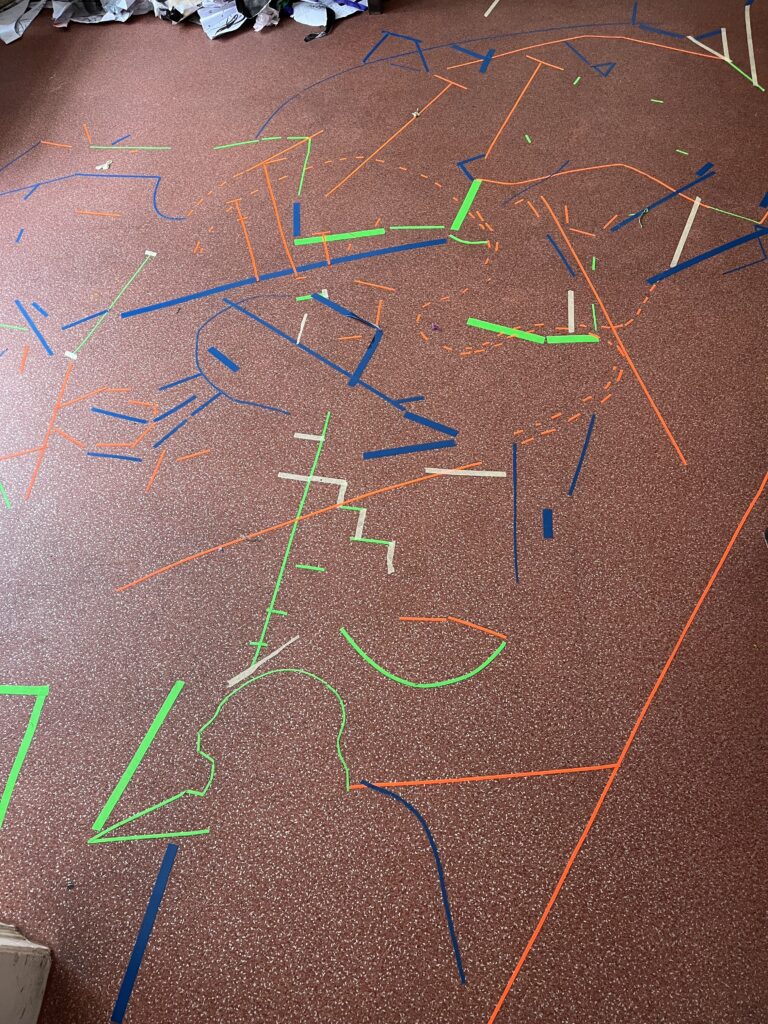
Later that day we investigated scale/light/volume/form and the transition from 2D/3D using large ink drawings which the participants, in small groups, tore and cut up to build scale models. By now it was becoming clear that everyone was beginning to gain confidence in each other and in allowing the drawings to lead them towards spatial solutions. Each group presented their model and revealed their discoveries.
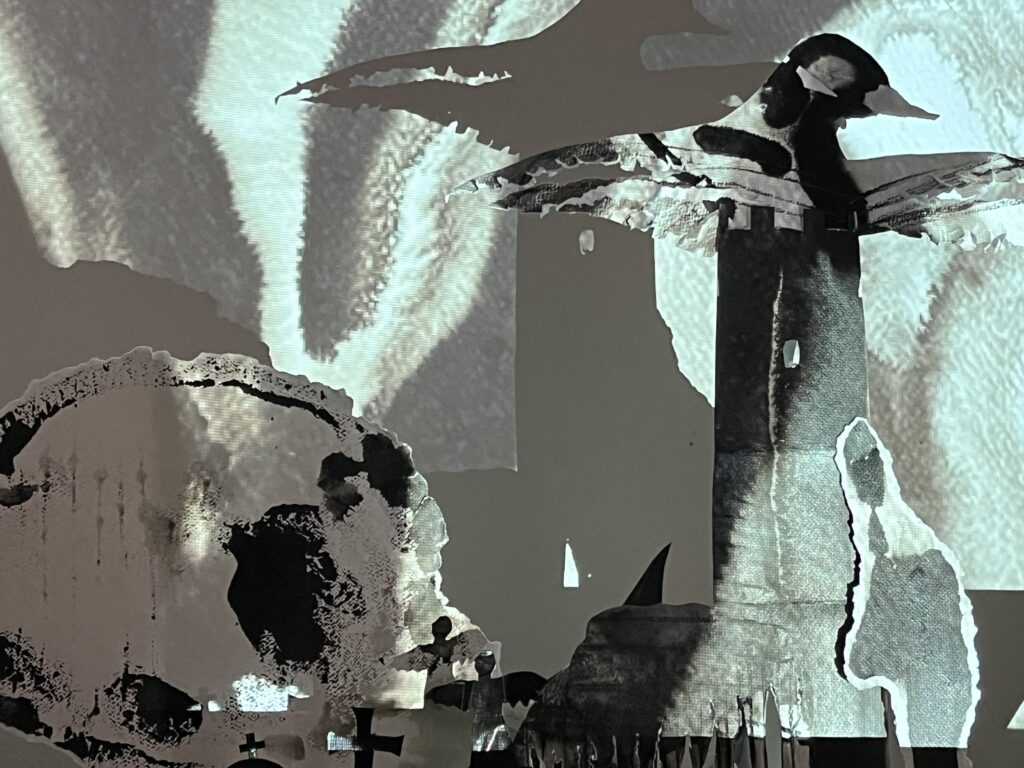
Workshop findings and reflections.
On day three using the word REFLECTION to lead us, we opened up the ‘stage’ to the participants to enable them to push their drawing and movement explorations in the directions they wanted to. It was fascinating to see how the sense of trust had grown and the third day seemed softer and more open to discovery. We settled into drawing and dancing together using the full range of drawing tools and materials. Gradually the studio walls were covered in drawings which enabled further discussions into how and why drawing performance encourages the sharing of practices and ideas. The participants felt that they had:
- Opened up, through drawing movement, using different materials and moving themselves and their own neurological and physical pathways, thereby creating new understandings of bodily structures and their relationship to the space around them.
- Shared and witnessed the loneliness of the performer and designer. At the end of the session the participants had fully engaged with performance and the performers through drawing. It seemed that the fear of trying something out had been overcome and a truly inclusive shared commitment to collaboration had emerged.
- Begun to trust mark-making and materiality as a productive ‘friend’ and disruptor in the rehearsal room and design studio. Consequently, confidence in their ability to notice, observe, and capture solutions as they reveal themselves grows.
- Allowed drawing to disrupt, intervene and make them question their approach.
These reflections are helping to shape our ever-growing drawing performance manifesto. Evidently the most important aspect of this work is trust, in each other as collaborators and in the drawing and making processes. This quote from dancer/choreographer Kirill Burlov, who has been my main collaborator since 2016, highlights the importance of designers physically understanding the performative potential of space.
I am aware that the design students usually enter the space very nervously, not knowing what to expect. Over the course of the day, it is evident that a massive transformation takes place and by the end of the day every design student has entered the performance space, despite being initially reluctant. This reveals to them the vulnerability and loneliness of the performer and consequently how vital it is that designers are sensitive to the performers needs and that they create spaces that performers can inhabit truthfully (Burlov, K. 2019)
I brought two concertina sketchbooks with me to the workshops. One became an incredibly sensitively drawn collaborative work. Interestingly I have found connection and calm since the workshop finished in repeatedly re-drawing the collaborative drawings. I take a section of the drawing and draw a new piece from it, taking special care to respond to the depth and thickness of each line. This process has offered me further insights into sightlines, placing and spacing, light and shade and the power of density when line making.
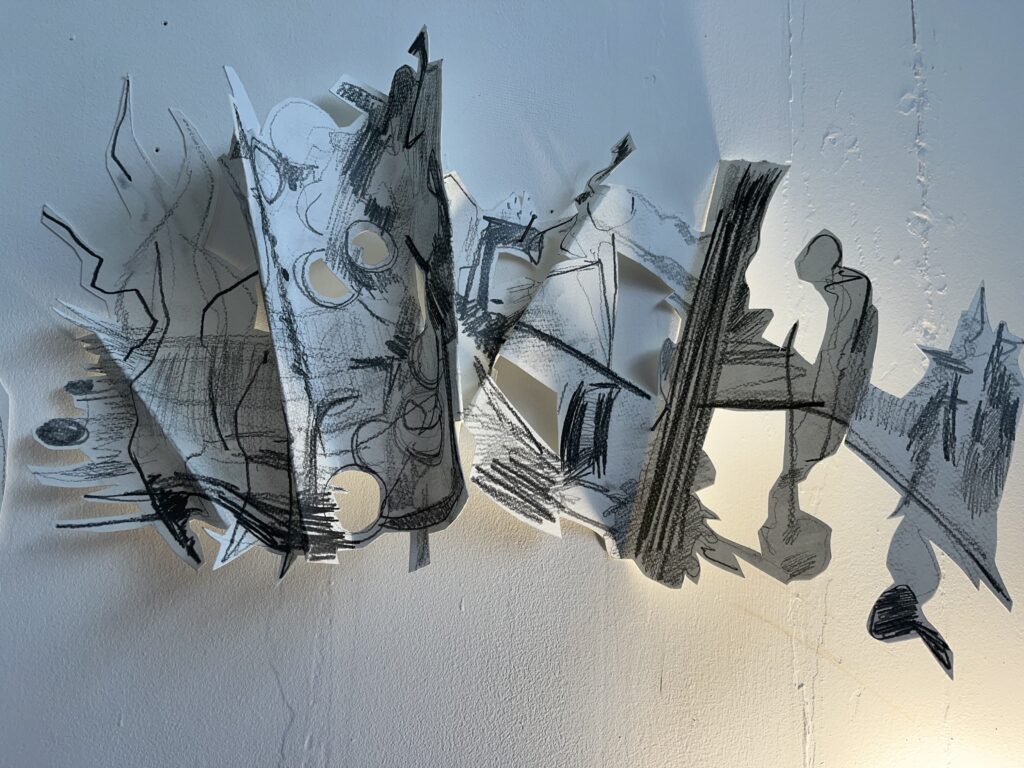
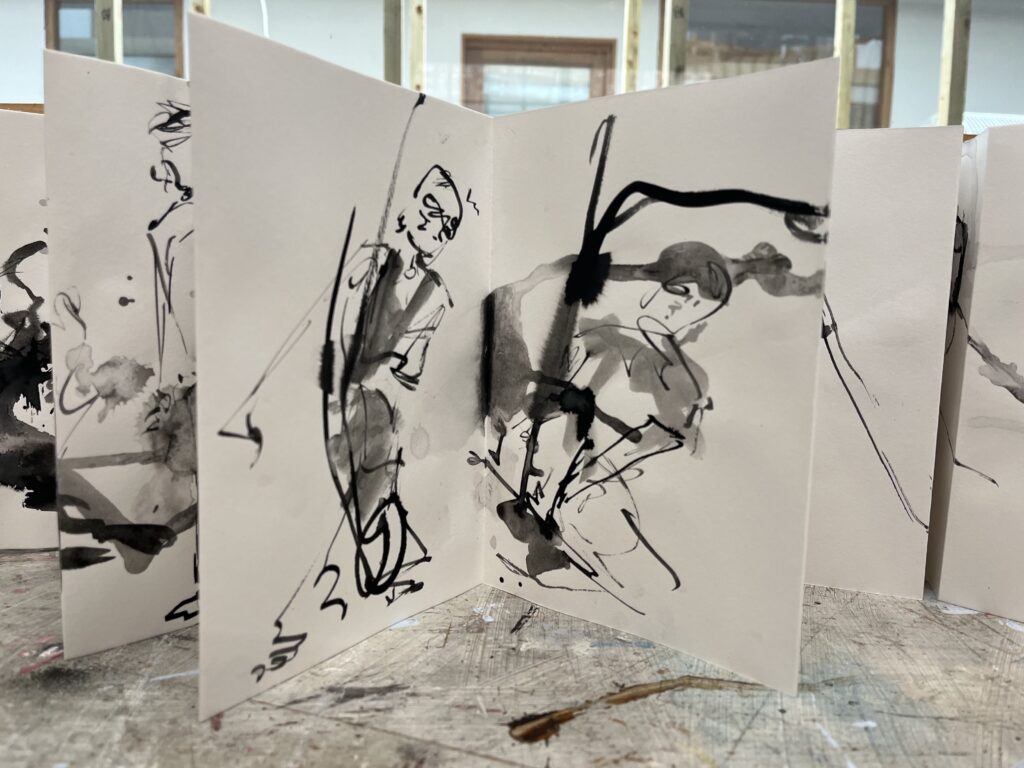
The other sketchbook gathered together reflective words, written by the participants, into a rather beautiful ‘poem’.
Phrase Day 1
Observation
Superposition
Generate
Flow
Score
Creativity
Metamorphosis
Translucence
Reflection/Reflexive
Creating space
Chance
Capture the rhythm of the emotional movement
Open minded
Frenetic
Liberty
Vanish/Reappear
Attention
Freedom
Leave traces
Echo
Performativity
Ambidextrous
Patience
Evolution
Chaos
Sightlines
Satisfaction
Proximity Day 2
Intimacy & Vulnerability
Drawing is portable where other theatre materials are fixed
Emotional potency of space
Avoidance
Mood
Sense of direction
Contact
Grateful
Sharing
Gaze
Patience
Meditative
Allow
Arrow
Body
Interesting
Don’t be shy
Much to encounter
Discover
Delicate
Reflection Day 3
Full circle
Fluidity
Confidence through distraction
Speed
Energy
Repetition & different outcomes
Completion
The taste of plums
Sound is drawing
Depassement
Interessant
Breathe
Dance
Let go
Fun & play
You do not have to understand what you are making but use it as a means to grow this understanding.
This final quote is from a chapter I wrote for Leap Into Action: Critical Performative Pedagogies in Art and Design Education edited by Lee Campbell.
Drawing provokes ideas to reveal themselves and the unpredictability of mark-making with charcoal or ink on thick cartridge paper, whilst observing dynamic movement, can offer the designer unexpected solutions. Even now, when digital drawing is bringing new communication possibilities to designers, ensuring that all my students have a breadth of knowledge of, and sensual delight in, the creative possibilities that drawing offers is vital. The senses are triggered in a different way by, for instance, the drag of pencil or pastel on rough paper, or watercolour running and creating previously unimagined ways forward. The understanding of line, shape and form needs to be nurtured so that the theatre designer can respond with equal alacrity and skill to the design demands of any performance. Ultimately, any process that extends visual language and physical knowledge will help to ensure that the students become, what all artists and designers must be; confident communicators and inventive and responsive collaborators. (Algar, 2019)
It was a huge privilege and great pleasure to work with such a responsive group of participants and co-leaders in Prague. Further collaborative investigations are being planned and our manifesto continues to grow.
Bibliography
Algar, L.2020. Drawing Performance: Creating Confident Collaborators Through Movement, Mark-Making, Dance and Dialogue. In: Campbell, L. ed. Leap Into Action: Critical Performative Pedagogies in Art and Design Education. New York: Peter Lang Publishing, pp. 193-202
Chitty, Alison. 2010. 1970-2010 Design Process London: Royal National Theatre Foundation
Kovats, Tania. 2014. Drawing Water. Edinburgh: The Fruitmarket Gallery
Lucy Algar, BA MA FHEA is an artist, performance designer and educator. She is the Course Leader of the BA Theatre Design course at Wimbledon College of Arts, UAL, a post she has held since 2013. Her work includes extensive design for performance both live and for film and TV, art installations in public environments & galleries & exhibition design. Her research and practice focuses on the role of drawing as the primary investigative and communication tool for performance designers.
Lucy Algar @drawingperformanceproject
https://www.instagram.com/drawingperformanceproject/?hl=en-gb
Lucy Algar Vimeo: https://vimeo.com/user111018947
